This mokume vase represents a time when appreciation for Japanese design and craftsmanship was taking the world (Tiffany & Company included) by storm. In the mid- to late 1850s, Japan was opened to commercial trade by Commodore Matthew C. Perry and several treaties. Many consumers were seeing Japanese crafts for the first time at World’s Fair exhibitions in 1862 (London), 1867 (Paris), and 1876 (Philadelphia). One such consumer was Tiffany & Co.’s chief metalwork designer Edward C. Moore, a talented silversmith. In 1877, Tiffany and Co. commissioned Christopher Dresser to travel to Japan and collect 8,000 Japanese textiles, jewelry, ceramics, and pieces of metalwork for study and auction.
Moore was fascinated by a Japanese metalworking technique called mokume-gane, which translates to “wood grain.” Moore set to work replicating the technique at his New York metalworks. Mokume is made by welding layers of several alloys composed of copper, silver, and gold. Varied shaped cuts are made into the layers. The entire piece is then beaten, rolled flat, and patinated, creating a unique wood grain pattern exposing the differing tones of the alloys. Moore embraced Japanese designs that were inspired by nature, incorporated negative space and asymmetrical designs. Moore’s creations won top awards at the 1878 Exposition Universelle in Paris, France.
Tiffany and Co. mokume designs are very rare as it is believed few were produced due to the labor involved in production. This vase in the Milwaukee Public Museum’s collection is a lovely example of the blending of cultures inspired by nature.
Catalog Number
N7612
Accession Number
10513
25


